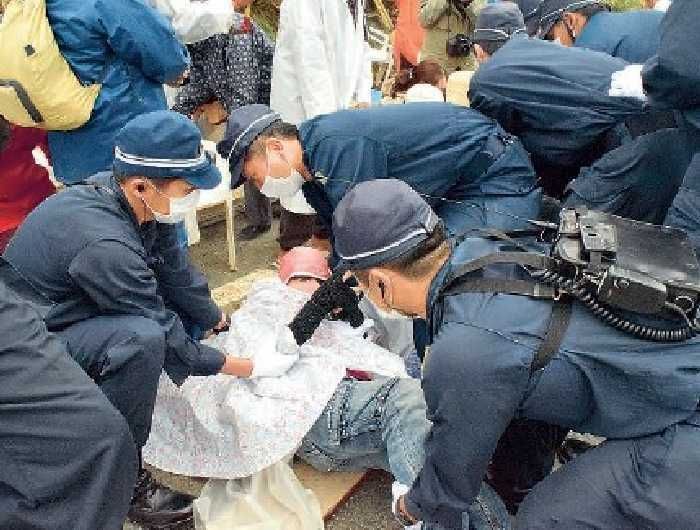Nagoya High Court makes “groundbreaking decision” in favor of Okinawa’s plaintiffs about riot police in Takae

In front of the N1 zone gate of the NTA on November 24, 2016, citizens were grasped by their hands and feet and forcibly moved by riot policemen
October 8, 2021 Ryukyu Shimpo
On October 7 the Nagoya High Court, ruling on a taxpayers’ suit concerning the deployment of riot police accompanying helipad construction in the Northern Training Area (NTA), made a decision that found illegality in the procedure used when choosing to deploy the riot police. The district courts of Tokyo, Nagoya, Fukuoka, and Naha all saw taxpayers’ suits charging that the deployment was illegal, but the taxpayers’ side lost in all of these first trials. The plaintiffs and interested parties from Okinawa feel hopeful that the Nagoya High Court finding in favor of some of the claims from the taxpayers’ side will “become a tailwind for Okinawa’s legal team”, and expressed their delight.
Tsuyoshi Kitaueda was directly contacted by Nagoya’s plaintiffs, and offered them words of encouragement, saying, “This is a splendid, groundbreaking decision.” The plaintiffs from each region had come together to cooperate as the plaintiffs in this suit in Okinawa. Kitaueda stated that the October 7 high court decision contained mention that the Okinawa Prefectural Public Safety Commission’s assistance request was significantly flawed, and he also explained that the decision was handed down with criticism for Okinawa’s handling of the situation, as well, and with an understanding of the crucial importance of the decision.
Yoichiro Hidaka, a lawyer experienced with lawsuits in Okinawa concerning the U.S. military, explained that in the first trial decision of this suit it was found that the procedural issue, specifically, the police chief of the Aichi Prefectural Police choosing to deploy the riot police on his own authority, was settled by an ex post facto report to the public safety commission. Hidaka also pointed out that the Nagoya High Court saw an issue with that finding because “it cannot be assessed, in an ex post facto report, that the public safety commission has performed substantial deliberation and approval/verification.” Hidaka also feels that the high court’s decision was appropriately judged on substance rather than logic.
The high court held that there is “strong doubt” about whether the riot police having removed vehicles and tents set up by citizens in front of the N1 zone gate of the NTA was illegal. Hidaka also touched on this matter, commenting: “The decision will become a tailwind for Okinawa’s legal team, as well. The Naha District Court avoided deciding upon whether or not the tent removal was illegal, but I expect that the Naha branch of the high court will face making that decision head-on.”
Kunio Uehara, one representative of the Okinawa Peace Movement Center, said that the Japanese government is using police authority to keep prefectural citizens down in order to carry out base construction, and suggested that the government is now being judged for its methods for moving construction forward, which go too far. He also said that although this lawsuit will probably go to the Supreme Court, he hopes that there, too, the judicial decision will uphold properly protecting the rights of Japanese citizens.
(English translation by T&CT and Erin Jones)
Previous Article:Foot traffic in Mihama still light day after emergency declaration lifted, “I look forward to the customers coming back”
Next Article:After 48 years in business, barbershop owner in Nago cuts his grandson’s hair for his final customer
[Similar Articles]
- Prefectural Assembly adopts resolution of protest against discriminatory remarks by riot police
- Onaga responds to riot police officer using discriminatory term for Okinawan protesters
- OPG loses lawsuit against Land Minister’s decision to cancel OPG’s revocation of land reclamation permission
- Dugong lawsuit appealed to U.S. High Court
- Tokyo riot police join security at Camp Schwab; protester arrested in scuffle
 Webcam(Kokusai Street)
Webcam(Kokusai Street)


